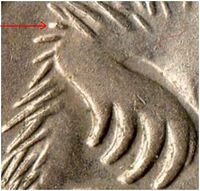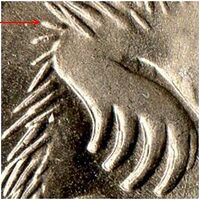Australian five-cent coin: Difference between revisions
No edit summary |
No edit summary |
||
| (3 intermediate revisions by the same user not shown) | |||
| Line 1: | Line 1: | ||
__FORCETOC__ | |||
=== Production === | |||
The Australian five-cent coin was first introduced with the transition to decimal currency on 14 February 1966. The original reverse design featuring the iconic echidna has remained unchanged since the coin's introduction over 50 years ago. In 2016, the obverse (front) design was updated to commemorate the 50th anniversary of Australia's decimalisation, but the echidna reverse has been a constant on the five-cent piece. | The Australian five-cent coin was first introduced with the transition to decimal currency on 14 February 1966. The original reverse design featuring the iconic echidna has remained unchanged since the coin's introduction over 50 years ago. In 2016, the obverse (front) design was updated to commemorate the 50th anniversary of Australia's decimalisation, but the echidna reverse has been a constant on the five-cent piece. | ||
| Line 7: | Line 6: | ||
Over the decades, the Australian five-cent coin has become an enduring symbol of the country's decimal currency system. Its reverse design featuring the distinctive spiny echidna has become instantly recognizable to Australians and is a testament to the ongoing legacy of the five-cent coin. | Over the decades, the Australian five-cent coin has become an enduring symbol of the country's decimal currency system. Its reverse design featuring the distinctive spiny echidna has become instantly recognizable to Australians and is a testament to the ongoing legacy of the five-cent coin. | ||
{| class="wikitable" | {| class="wikitable" | ||
|+ | |+ | ||
| Line 31: | Line 29: | ||
| align="center" |Elizabeth II | | align="center" |Elizabeth II | ||
| align="center" |Arnold Machin | | align="center" |Arnold Machin | ||
| colspan="2" align="center" |1966-1984 | | colspan="2" align="center" |1966-1984 | ||
|- | |- | ||
| Line 43: | Line 40: | ||
| align="center" |Elizabeth II | | align="center" |Elizabeth II | ||
| align="center" |Ian Rank-Broadley | | align="center" |Ian Rank-Broadley | ||
| colspan="2" align="center" |1999-2015 | | colspan="2" align="center" |1999-2015 | ||
2017-2019 | 2017-2019 | ||
| Line 50: | Line 46: | ||
| align="center" |Elizabeth II and Reproduction of 1953-1964 One Penny | | align="center" |Elizabeth II and Reproduction of 1953-1964 One Penny | ||
| align="center" |Ian Rank-Broadley | | align="center" |Ian Rank-Broadley | ||
| colspan="2" align="center" |2016 | | colspan="2" align="center" |2016 | ||
|- | |- | ||
| Line 56: | Line 51: | ||
| align="center" |Elizabeth II | | align="center" |Elizabeth II | ||
| align="center" |Jody Clark | | align="center" |Jody Clark | ||
| colspan="2" align="center" |2019-2023 | | colspan="2" align="center" |2019-2023 | ||
|- | |- | ||
| Line 63: | Line 57: | ||
Special Memorial | Special Memorial | ||
| align="center" |Jody Clark | | align="center" |Jody Clark | ||
| colspan="2" align="center" |2023 | | colspan="2" align="center" |2023 | ||
|- | |- | ||
| Line 69: | Line 62: | ||
| align="center" |Charles III | | align="center" |Charles III | ||
| align="center" |Dan Thorne | | align="center" |Dan Thorne | ||
| colspan="2" align="center" |2024-Present | | colspan="2" align="center" |2024-Present | ||
|- | |- | ||
| Line 75: | Line 67: | ||
! align="center" |'''Design''' | ! align="center" |'''Design''' | ||
! align="center" |'''Designer''' | ! align="center" |'''Designer''' | ||
! colspan="2" align="center" |'''Design date''' | ! colspan="2" align="center" |'''Design date''' | ||
|- | |- | ||
| Line 84: | Line 75: | ||
|- | |- | ||
|} | |} | ||
=== Mintage Figures === | |||
{|class="wikitable" | {|class="wikitable" | ||
|+ | |+ | ||
| Line 136: | Line 126: | ||
|RAM | |RAM | ||
|} | |} | ||
{|class="wikitable" | {|class="wikitable" | ||
|+ | |+ | ||
| Line 314: | Line 303: | ||
| | | | ||
|} | |} | ||
{| class="wikitable" | {| class="wikitable" | ||
|+ | |+ | ||
| Line 325: | Line 311: | ||
|} | |} | ||
=== Mint Marks === | |||
The two different variants of the 1966 Australian five-cent coin minted in London and Canberra can be readily distinguished by a key visual difference in their reverse designs. Specifically, the length of the spine on the echidna's front right shoulder is notably longer on the coins produced at the Royal Mint in London compared to the shorter spine on the Canberra-minted coins from the Royal Australian Mint. | The two different variants of the 1966 Australian five-cent coin minted in London and Canberra can be readily distinguished by a key visual difference in their reverse designs. Specifically, the length of the spine on the echidna's front right shoulder is notably longer on the coins produced at the Royal Mint in London compared to the shorter spine on the Canberra-minted coins from the Royal Australian Mint. | ||
| Line 337: | Line 322: | ||
|+ | |+ | ||
! align="center" |RAM (Canberra) | ! align="center" |RAM (Canberra) | ||
! align="center" | | ! align="center" |RML (London) | ||
|- | |- | ||
| align="center" |[[File: | | align="center" |[[File:MintMark5ccan.jpg|200px]] | ||
| align="center" |[[File: | | align="center" |[[File:MintMark5cldn.jpg|200px]] | ||
|- | |- | ||
|<small>Canberra Mint: | |<small>Canberra Mint: Short spine.</small> | ||
|<small> | |<small>London Mint: Longer spine.</small> | ||
|} | |} | ||
<small>Source: https:// | <small>Source:</small> https://en.numista.com/forum/topic40798.html | ||
Latest revision as of 04:48, 25 June 2024
Production
The Australian five-cent coin was first introduced with the transition to decimal currency on 14 February 1966. The original reverse design featuring the iconic echidna has remained unchanged since the coin's introduction over 50 years ago. In 2016, the obverse (front) design was updated to commemorate the 50th anniversary of Australia's decimalisation, but the echidna reverse has been a constant on the five-cent piece.
All of the initial 1966 production run of five-cent coins was carried out at the Royal Mint in London. Since those first coins minted in the UK, subsequent five-cent pieces have been produced by several mints, including the Royal Australian Mint, the Royal Mint in Llantrisant, Wales, and the Royal Canadian Mint.
Over the decades, the Australian five-cent coin has become an enduring symbol of the country's decimal currency system. Its reverse design featuring the distinctive spiny echidna has become instantly recognizable to Australians and is a testament to the ongoing legacy of the five-cent coin.
| Value | Mass | Diameter | Edge | Composition |
|---|---|---|---|---|
| $0.05 AUD | 2.83 g | 19.41 mm | Milled | 76% copper 25% nickel |
| Obverse | Design | Designer | Design date | |
| Elizabeth II | Arnold Machin | 1966-1984 | ||
| Elizabeth II | Raphael Maklouf | 1985-1998 | ||
| Elizabeth II | Ian Rank-Broadley | 1999-2015
2017-2019 | ||
| Elizabeth II and Reproduction of 1953-1964 One Penny | Ian Rank-Broadley | 2016 | ||
| Elizabeth II | Jody Clark | 2019-2023 | ||
| Elizabeth II
Special Memorial |
Jody Clark | 2023 | ||
| Charles III | Dan Thorne | 2024-Present | ||
| Reverse | Design | Designer | Design date | |
| Short beaked Echidna | Stuart Devlin | 1966-Present | ||
Mintage Figures
| Mintage year | 1966 | 1966 | 1967 | 1968 | 1969 | 1970 | 1971 | 1972 | 1973 | 1974 | 1975 | 1976 | 1977 | 1978 |
|---|---|---|---|---|---|---|---|---|---|---|---|---|---|---|
| Mintage (Mil) | 30.0 | 45.4 | 62.1 | 67.3 | 38.2 | 46.1 | 39.5 | 8.3 | 48.8 | 64.2 | 44.3 | 113.2 | 108.8 | 25.2 |
| Mint | RML | RAM | RAM | RAM | RAM | RAM | RAM | RAM | RAM | RAM | RAM | RAM | RAM | RAM |
| Mintage year | 1979 | 1980 | 1981 | 1981 | 1981 | 1982 | 1983 | 1984 | 1987 | 1988 | 1989 | 1990 | 1991 | 1992 |
|---|---|---|---|---|---|---|---|---|---|---|---|---|---|---|
| Mintage (Mil) | 44.5 | 115 | 62.0 | 50.0 | 50.3 | 139.5 | 131.6 | 43.5 | 73.5 | 103.4 | 95.8 | 33.3 | 29.9 | 52.6 |
| Mint | RAM | RAM | RAM | RCM | RMLL | RAM | RAM | RAM | RAM | RAM | RAM | RAM | RAM | RAM |
| Mintage year | 1993 | 1994 | 1995 | 1996 | 1997 | 1998 | 1999 | 2000 | 2001 | 2002 | 2003 | 2004 | 2005 | 2006 |
|---|---|---|---|---|---|---|---|---|---|---|---|---|---|---|
| Mintage (Mil) | 93.8 | 156.7 | 85.0 | 79.2 | 100.7 | 88.5 | 179.5 | 97.4 | 174.6 | 148.8 | 115.1 | 145.3 | 194.3 | 306.5 |
| Mint | RAM | RAM | RAM | RAM | RAM | RAM | RAM | RAM | RAM | RAM | RCM | RMLL | RAM | RAM |
| Mintage year | 2007 | 2008 | 2009 | 2010 | 2011 | 2012 | 2013 | 2014 | 2015 | 2016 | 2016 | 2017 | 2018 | 2019 |
|---|---|---|---|---|---|---|---|---|---|---|---|---|---|---|
| Mintage (Mil) | 59.0 | 200.2 | 83.9 | 55.1 | 44.8 | 68.9 | 78.7 | 76.0 | 21.2 | 34.4 | 4.81 | 18.6 | 25.1 | 46.22 |
| Mint | RAM | RAM | RAM | RAM | RAM | RAM | RAM | RAM | RAM | RAM | RAM | RAM | RAM | RAM |
| Mintage year | 2019 | 2020 | 2021 | 2022 | 2023 | 2024 |
|---|---|---|---|---|---|---|
| Mintage (Mil) | 2.03 | 49.9 | 36.7 | 49.0 | ||
| Mint | RAM | RAM | RAM | RAM |
| RAM = Royal Australian Mint; RCM = Royal Canadian Mint; RML = Royal Mint, London; RMLL=Royal Mint, Llantrisant |
| 1 = 50th Anniversary, 2= IRB, 3 = JC |
Mint Marks
The two different variants of the 1966 Australian five-cent coin minted in London and Canberra can be readily distinguished by a key visual difference in their reverse designs. Specifically, the length of the spine on the echidna's front right shoulder is notably longer on the coins produced at the Royal Mint in London compared to the shorter spine on the Canberra-minted coins from the Royal Australian Mint.
This subtle but distinct design variation provides a helpful diagnostic feature for collectors and enthusiasts seeking to differentiate between the two 1966 five-cent coin varieties. The longer spine on the London-minted coins creates a more pronounced and pronounced quill-like appearance, whereas the Canberra coins have a shorter, less emphasized spine on the same part of the echidna's body.
In terms of production numbers, the Royal Mint in London struck 30 million of the 1966 five-cent coins. Meanwhile, the Canberra facility of the Royal Australian Mint produced over 45 million examples of the 1966 five-cent piece. As a result, the Canberra-minted coins are the more prevalent and commonly encountered of the two 1966 five-cent varieties among collectors and in circulation.
This clear visual distinction and difference in mintage figures makes the longer vs. shorter spine on the echidna's front right shoulder an essential diagnostic tool for identifying the origin mint of individual 1966 Australian five-cent coins. It's a key detail that numismatists and coin enthusiasts can use to accurately attribute and catalogue examples of this important decimal currency issue.
| RAM (Canberra) | RML (London) |
|---|---|

|

|
| Canberra Mint: Short spine. | London Mint: Longer spine. |